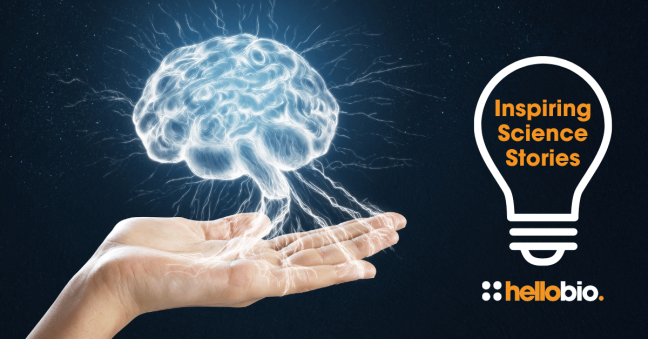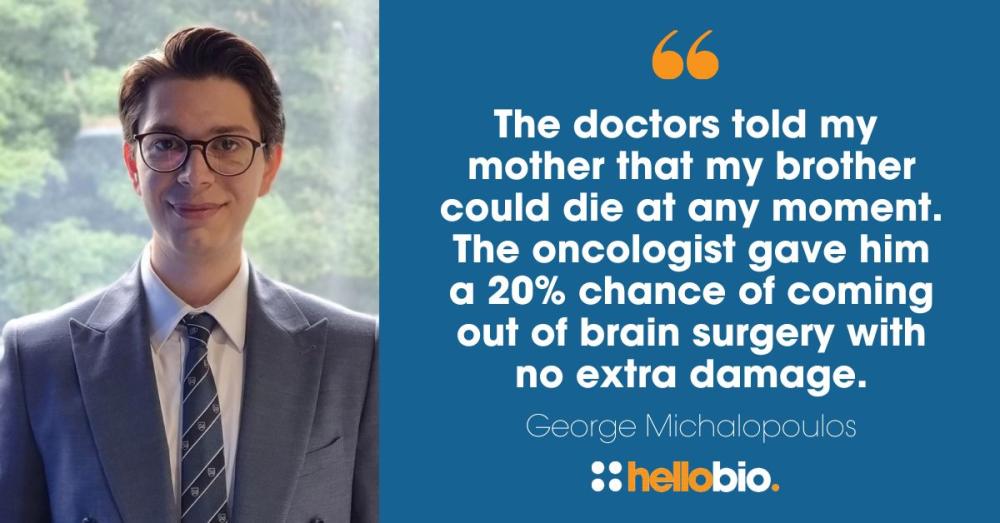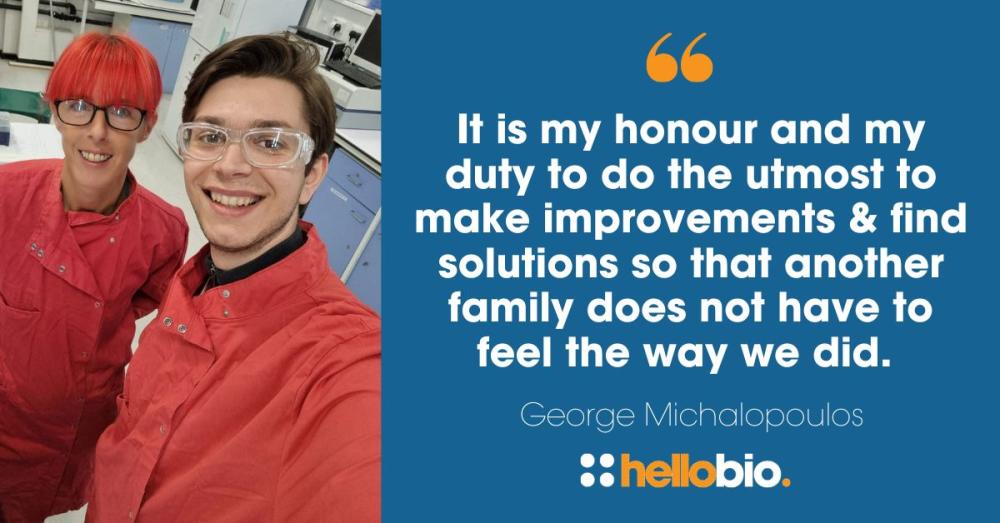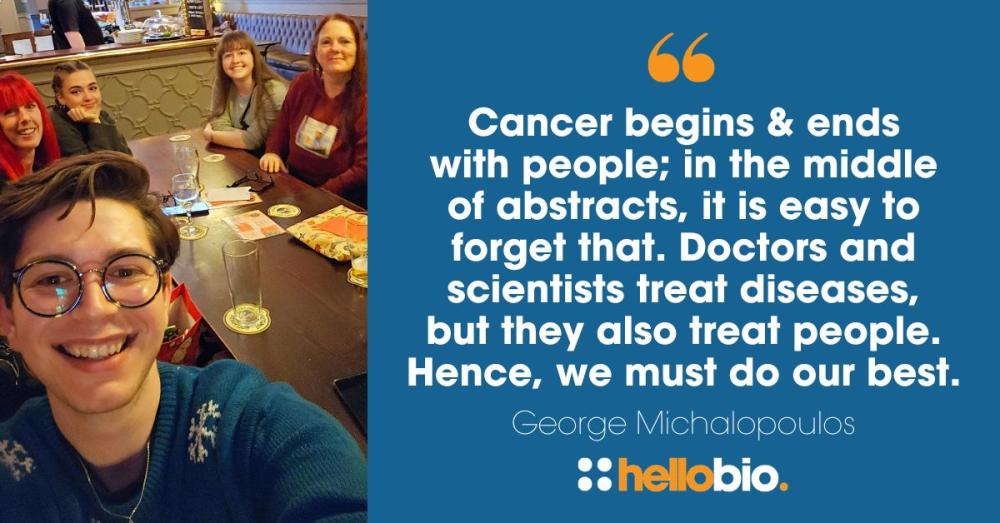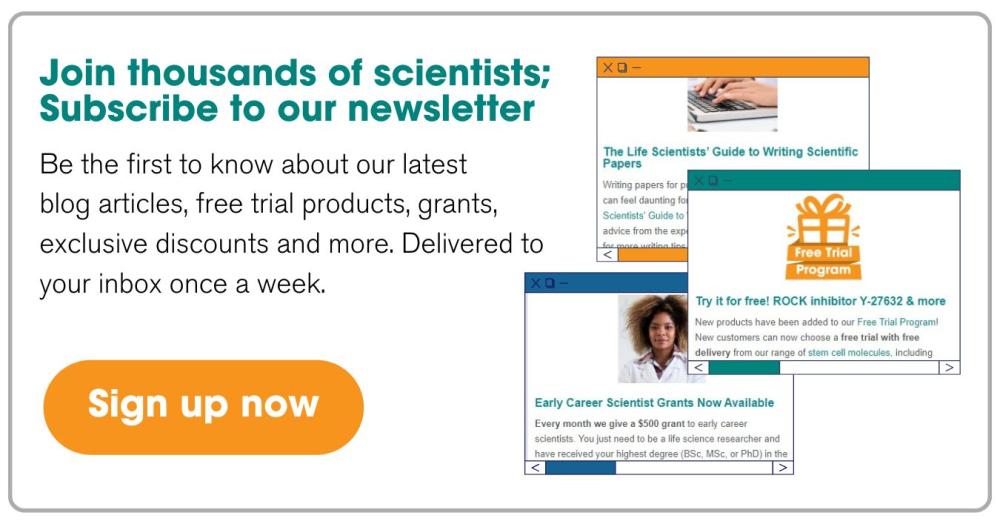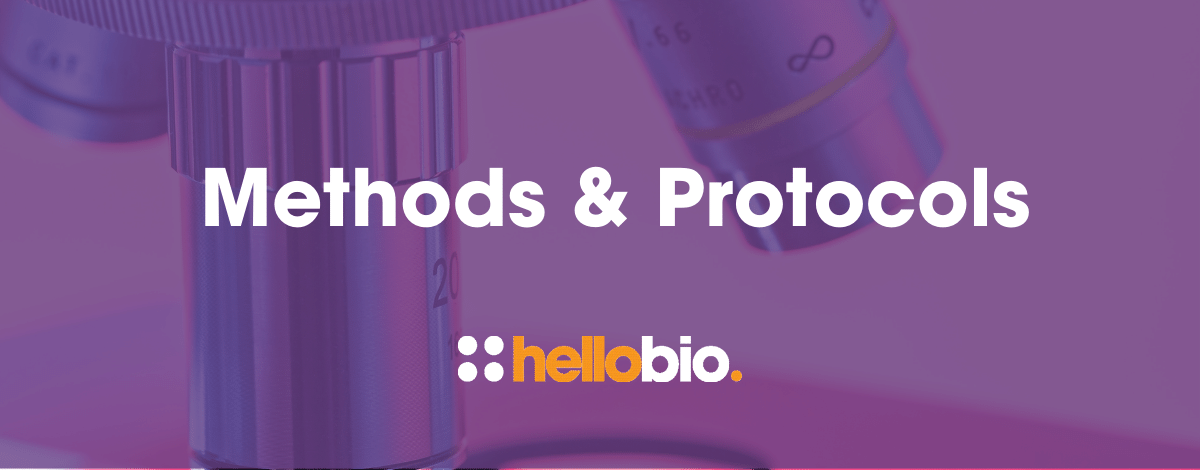Inspiring Science Stories: Brotherhood, Bravery & Brain Tumour Research
PhD candidate George Michalopoulos is making a name for himself at the University of Huddersfield as one of the brightest young researchers in the field of brain cancer. Described by his project supervisor Anke Brüning-Richardson as ‘passionate’ and ‘committed to making a difference’, George has big ambitions to improve the experiences and treatment options for patients with brain tumours.
His drive to achieve great things in science can be directly attributed to a traumatic personal experience, having witnessed his younger brother being diagnosed with a brain tumour and feeling powerless to help. In this inspiring article, George shares his story, his career journey to date, and his hopes for the future of Glioblastoma research.
The first steps on my STEM journey
For as long as I can remember, I was interested in doing something STEM-related, but it always seemed out of reach to me. If you were to ask my grandparents, they would tell you that I was (and still am) the child that would fix everything around the house! From the TV to a loose screw in one of the cupboards, or perhaps a new light that needed to be installed, I loved fixing anything I could get my hands on, and when I got my first taste of practical science and biology at school it felt as though an important jigsaw piece was fitting into place for me.
I followed quite an unorthodox path into science research, as I was the last generation of students able to obtain a loan for tuition fees. I finished my mandatory education in a small suburb of Athens, Greece, and went on to public school where I took Applied Life Sciences. In my own time I practised for the IELTS English exam which was one of the requirements to study abroad, and then followed the same path as any other student, applying through UCAS for a place at a university in the UK.
Bravery & brotherhood
Moving abroad was not easy, in fact it very much felt impossible since the first time I ever got on a plane was to move to a different country, and nothing could have prepared me for the enormity of that at 18 years of age. However, I was driven by a strong desire to make a difference, and I drew strength from my family and their bravery following a traumatic series of events that had happened several years previously.
A brain tumour diagnosis
It was September 2012, my first year and first day at ‘big school’. I should have been excited, yet I woke up alone that day because my family were all at the hospital changing shifts to be with my 2-year-old brother. As you can imagine, at the age of 12 there was only so much I could understand, but I remember one thing crystal clear - my mother telling me ‘I want you to know these are very difficult times and I need you to be strong as your brother is really unwell’. My first thought was ‘is he?’ - he was fine yesterday!
It seemed that my brother was growing up a little bit faster than the rest of the children his age, which naturally raised concerns for my parents and the family doctor. After an X-ray of his arm to check the bone density which corresponds to the biologically expected growth, as well as his testosterone levels, they both indicated that the biological age of my brother was registering the equivalent of a child of 7 years, not 2.
He quickly underwent a brain MRI, which confirmed the one thing everyone was fearing… a brain tumour. The diagnosis stated that an identified glioma-looking growth was found, as well as a tumour at the hypophysis of his brain which was pressing against the optic nerve. The oxymoron of this situation was that the doctors were speaking, communicating and interacting with my brother as if there was nothing there, which was theoretically impossible considering his functions and eyesight should have been affected considerably. It was at this point that the doctors told my mother ‘you cannot leave, he could die at any moment, we must do a biopsy’. The oncologist gave my mother a 20% success rate of my brother coming out of surgery with no extra damage, as well as the consequences from having such invasive surgery. He was a VERY special case, to the point where we even received offers from specialist teaching hospitals in America to perform the surgery over in the US.
A miraculous outcome
Despite our worst fears, no surgery was actually performed. Whether it was a miracle or divine intervention of some sort, for some inexplicable reason, the glioma had vanished within days of the various MRIs and scans being done. Somehow, the tumour had shrunk by itself without any medical intervention or medication being administered. Ever since then my brother has been on injections to lower his testosterone, but he is now living as a happy and healthy teenager today.
Watching my brother and our family go through such a terrifying and difficult ordeal stayed with me, and when it came to choosing my specialism in science research, there was only one path I wanted to take. After completing my undergraduate degree in Biomedical science, I began applying for PhD positions and was successful in securing a fully funded scholarship at the University of Huddersfield through EPSRC, allowing me to pursue my research into ‘a novel in vitro model for studying drug responses to Glioblastoma cell migration in a native extracellular matrix microenvironment.’ This award was surely the proudest moment of my career so far.
The unique challenges of GBM research
For the majority of the patients diagnosed with Glioblastoma (GBM), it is an aggressive grade 4 brain cancer and therefore a terminal illness leaving patients with an average of 15 months to live. As we all know, there are numerous areas in research where new ideas, more focus, more resources and more hope is needed. Choosing ‘what I should specialise in’, ‘what research area should I get into’, and ‘where can I do the best to help’ is as difficult as choosing what to study.
In my current research, I am aiming to transform our understanding of GBM. Current therapies are largely ineffective, resulting in a bleak prognosis for patients. It is also very difficult to diagnose GBM at an early stage, although one way would be with the specific development of liquid biomarkers that are released somehow into the bloodstream from the growing tumours. Nevertheless, we still need to better understand the behaviour, morphology and subtypes of GBM which is exactly what we are working on today, and I am looking at many different aspects, behaviours and characteristics of GBM. This model comprises patient-derived glioma cells, cocultured, in hypoxic conditions, with a panel of Crispr-activated fibroblast cell lines overexpressing extracellular matrix (ECM) proteins that reflects the stoichiometric composition of the GBM and normal matrisome, in 3D-printed scaffolds that mimic GBM stiffness and morphometry, and imaged using a custom-designed AI-driven algorithm. This system allows the unprecedented modelling and manipulation of tumour ECM milieu and will provide a more accurate model for GBM biology and drug discovery.
The desire to make a difference
Seeing what my family went through has been the driving factor in my desire to make things better for GBM patients. Our family witnessed a lack of treatment options, and huge delays in understanding my brother’s unique situation. I am not sure how other scientists feel but sometimes when I find myself repeating the same experiment and anticipating that key result that will progress your research, yet that result ‘never’ comes within the week you need it to because there are deadlines, expectations, etc. I can get a little discouraged and disappointed, just like any human that has emotions.
As lab researchers we rarely get to see or meet patients, we only work with cell lines, and unless they are different types or subtypes of cells they will all look the same. It’s important to remember that the work you are doing ‘is not for me’ and is not simply something to satisfy my thirst for knowledge. In fact what I have in front of me are patient derived cell lines from people that have lost their lives, and I am lucky enough to be able to utilise them towards a better tomorrow for future patients. That is why when people ask me if it is difficult to study a subject with which I have such personal and emotional connections, I say no! Those connections remind me why I am here, and it is my honour and my duty to do the utmost to make improvements and find solutions so that another family does not have to feel the way we did.
The future of cancer research
I often read about diabetes and how it used to be a death sentence until insulin was formulated, it then became a chronic disease. In an ideal world, I would like for cancer to cease to exist and be treated once and for all. But when you look at it, it appears to be a humongous mountain that no one has climbed. Whereas if you see it as a perfect place for steps to be created with each scientist building one, then the dream starts becoming a reality. Before we know it, we will all collaboratively climb the ladder and beat cancer one step at a time. I hope to see personalised treatments tailored to each patient and diagnoses that are full of hope no matter what the type of cancer.
To achieve these goals, one of the biggest challenges we must overcome is the lack of funding and resources. Despite having an amazing team with great ideas and eagerness, the lack of funds to progress our research and apply our theories is significant. Research is very expensive. Despite this, I truly believe that the biggest discoveries are made when people are lacking something, pushing them to the limit of creativity and innovation where a shortcut can be a new novel and revolutionary invention.
Inspiring the next generation
I enjoy being a mentor and ambassador to younger students, and I absolutely love teaching in higher education. I think it is magical how curious people gather to explore the unknown parts of science. When faced with the unknown, hope is created. This is where ideas are born and this is how I got into research! If you ask me where do I see myself in 10 years? The answer is where science takes me! Throughout history when the world has been dichotomised, fraught and divided, science has always been one of the things that has kept us together, the very thing that we are all in together. Hence, no matter where on this earth I might be, the moral stays the same, and the aim will only be reinforced. We are here to help and make lives better in the long term. Cancer begins and ends with people; in the middle of scientific abstracts, it is sometimes possible to forget this one basic fact. Doctors and scientists treat diseases, but they also treat people. Hence, we must do our best.
Connect with George Michalopoulos
- LinkedIn: George Michalopoulos
- X(Twitter): @GeorgeMichalop5
- Instagram: @george__michalopoulos
________________________________
If you enjoyed this article, why not check out the other resources available on our blog. We are passionate about supporting life scientists including early career life scientists and PhD students - with really low-priced reagents, antibodies and biochemicals, early career scientist grants, and resources to help with both personal and professional development. We know how tough it is - so we hope you find these helpful!
More General Support for Life Scientists
For advice on wellbeing, dissertations, presenting at conferences, wellbeing, PhD support, networking and lots more, we have a huge range of articles to help - just click below:
Save up to 50% on our high purity reagents...
When you get to the stage of planning your experiments, don't forget that we offer a range of low-cost, high-purity agonists, antagonists, inhibitors, activators, antibodies and fluorescent tools (yes - they really are around half the price of other suppliers!) You can use our Quick Multi-Search Tool to search for lots of products in one go, and the range includes:
- Enzyme inhibitors and activators
- Chemogenetic ligands
- Ion channel modulators
- GPCR & ionotropic receptor ligands
- Cell biology reagents & biochemicals
Technical resources
Try our Molarity Calculator: a quick and easy way to calculate the mass, volume or concentration required for making a solution.
Try our Dilution Calculator: an easy way to work out how to dilute stock solutions of known concentrations
We also offer a comprehensive range of technical resources including antibody protocols and methods, product guides and mini-reviews:
And finally, don't forget to check back in with our blog regularly for our latest articles. If there’s something you’d love to contribute to the community, whether that’s an interview or article, drop us a line at hello@hellobio.com
---





